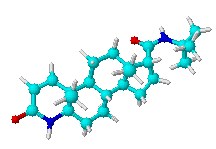According to the People’s Daily Online, the first Vietnamese have died of H3N0 another strain of the influenza A virus, related to but different from the increasingly familiar H5N1. From the scaremongering point of view, there’s no need to hold the frontpage (at least outside Vietnam) as this strain is far less virulent than H5N1.
However, it does bring to light an aspect of flu viruses that gets little mention in the media – avian influenza has killed very few people, especially compared with the number of annual deaths from human influenza, but should any of these avian strains jump between species they are likely to lose their virulence to a great degree. One flu expert told us that, “H5N1 will surely decrease in lethality as it becomes more infectious between humans…no doubt about it.” More on that next week…
 Premier molecular modeller Stephan Logan has produced for us a timely reminder of the chemical structure of Tamiflu, the antiviral flu drug. You can order the necessary components to build the Molecular Model of Oseltamivir (Tamiflu) and other molecules from Stephan’s site. Perfect for that avian flu lecture!
Premier molecular modeller Stephan Logan has produced for us a timely reminder of the chemical structure of Tamiflu, the antiviral flu drug. You can order the necessary components to build the Molecular Model of Oseltamivir (Tamiflu) and other molecules from Stephan’s site. Perfect for that avian flu lecture!
 In his otherwise intriguing book, Digital Fortress ($7.99 in paperback from Amazon US), author Dan Brown makes several schoolboy errors. For instance, top of page 69 he says that, “Computer viruses were as varied as bacterial viruses…”
In his otherwise intriguing book, Digital Fortress ($7.99 in paperback from Amazon US), author Dan Brown makes several schoolboy errors. For instance, top of page 69 he says that, “Computer viruses were as varied as bacterial viruses…”